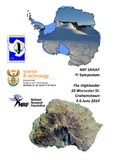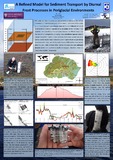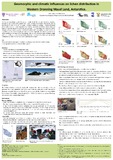
Antarctic Legacy Archive
Plot- and slope-scale topographic and vegetation control on ground temperature spatial variability: synoptic-scale observations from Marion Island
- ALSA Home
- →
- Documents
- →
- Research: Events, Presentations, Posters
- →
- View Item
JavaScript is disabled for your browser. Some features of this site may not work without it.
| dc.contributor.author | Boelhouwers, J. | |
| dc.coverage.spatial | sub-Antarctic | |
| dc.coverage.spatial | Marion Island | |
| dc.date.accessioned | 2021-03-10T09:25:42Z | |
| dc.date.available | 2021-03-10T09:25:42Z | |
| dc.date.created | 2007/10/09 | |
| dc.date.issued | 2007/10/09 | |
| dc.identifier.uri | http://hdl.handle.net/123456789/28549 | |
| dc.description.abstract | Marion Island is centrally located in the global belt of diurnal soil frost environments. It's maritime location results in a high frequency of diurnal frost cycles that cause globally- unequalled rates of sediment displacement. Landscape-scale understanding of soil frost dynamics on Marion Island and its interactions with terrestrial ecosystems requires an understanding of spatial and temporal patterns of the environmental controls driving and constraining soil frost action. As frost cycles occur at the synoptic time-scale this is the temporal scale at which analysis should be focused. At the spatial scale, local topography and vegetation plays an important control on the radiation budget and other micro-climatic parameters. In this study, measurement results are presented of i) slope aspect control on soil temperature at the block- to slope scale, ii) diurnal spatial variability of soil surface temperature and moisture within a 18xl0m plot, iii) micro-climate variations, both upwind-downwind and upslope-downslope, from Azorella selago cushions. Results from all three situations clearly establishes that cloud cover and air circulation type plays a dominant role in explaining ground climate spatial variability. Westerly air circulation results in mild and uniform temperatures across the landscape. In contrast, clear sky conditions associated with southerly air circulation creates a large temperature differentiation in the landscape, based primarily on topographic control of the radiation budget. Complex interactions between soil climate parameters and atmosphere are found around Azorella selago. A reduction in cloud cover, as suggested by Smith (2002) 1 is predicted to increase diurnal soil temperature and moisture extremes and their spatial variability across Marion Island and will increase the role of slope aspect as a control on soil frost cycle frequency and intensity. Enhanced nocturnal radiative heat loss will also (partially) offset, or even reverse, atmospheric warming effects on ground frost on cooler slopes. This can lead to a higher spatial variability in soil movement rates and indirectly, increased patchiness in vegetation patterns. Longer term ground temperature monitoring at an island scale is underway to further test this hypothesis. A synoptic climate classification is also being developed to understand decadal changes in dominant air circulation patterns at the island. | en_ZA |
| dc.description.sponsorship | Sponsored by the the Department of Science and Innovation(DSI) through National Research Foundation (NRF) - South Africa | en_ZA |
| dc.description.statementofresponsibility | Antarctic Legacy of South Africa | en_ZA |
| dc.format | en_ZA | |
| dc.language | English | en_ZA |
| dc.publisher | South African National Antarctic Programme (SANAP) | en_ZA |
| dc.relation | SANAP Symposium 2007 | en_ZA |
| dc.relation.ispartof | ARESSA THEME III: Biodiversity: Responses to Earth System Variability (Posters) | en_ZA |
| dc.rights | Copyright | en_ZA |
| dc.rights | Copyright | en_ZA |
| dc.subject | Research | en_ZA |
| dc.subject | Science | en_ZA |
| dc.subject | Meetings | en_ZA |
| dc.subject | Symposium | en_ZA |
| dc.subject | SANAP Symposium 2007 | en_ZA |
| dc.subject | sub-Antarctic | en_ZA |
| dc.subject | Marion Island | en_ZA |
| dc.subject | Earth Systems | en_ZA |
| dc.subject | Research | en_ZA |
| dc.subject | Earth Science | en_ZA |
| dc.subject | Geomorphology | en_ZA |
| dc.subject | Geo Sciences | en_ZA |
| dc.subject | Earth Sciences | en_ZA |
| dc.subject | Terrestrial Science | en_ZA |
| dc.subject | Soil Frost | en_ZA |
| dc.subject | Climate Change | en_ZA |
| dc.subject | Ground Temperature | en_ZA |
| dc.subject | Soil Temperature | en_ZA |
| dc.subject | Soil Frost | en_ZA |
| dc.title | Plot- and slope-scale topographic and vegetation control on ground temperature spatial variability: synoptic-scale observations from Marion Island | en_ZA |
| dc.type | Abstracts | en_ZA |
| dc.rights.holder | Antarctic Legacy of South Africa | en_ZA |
| dc.rights.holder | Boelhouwers, J. | en_ZA |
| iso19115.mdconstraints.uselimitation | This item and the content of this website are subject to copyright protection. Reproduction of the content, or any part of it, other than for research, academic or non-commercial use is prohibited without prior consent from the copyright holder. | en_ZA |
| iso19115.mddistributor.distributorcontact | South African National Antarctic Programme (SANAP) | en_ZA |
| iso19115.mdformat.name | en_ZA | |
| iso19115.mdidentification.deliverypoint | Antarctic Legacy of South Africa, Faculty of Science, Private Bag X1, Matieland. Stellenbosch. South Africa. | en_ZA |
| iso19115.mdidentification.electronicmailaddress | antarcticlegacy@sun.ac.za | en_ZA |
| iso19115.mdidentification.organizationname | Uppsala University | en_ZA |
Files in this item
This item appears in the following Collection(s)
-
Research: Events, Presentations, Posters [483]
Material directly related to official scientific and research events



